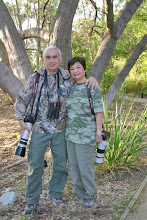The very first bird we encountered was the Purple Heron. As it turned out this would be the bird of the day - having encountered it at different places.
As I negotiated the challenging deeply rutted dirt road, we were frustrated by surprising skittishnesss of both the Zebra Doves and Red Turtledoves. We would see them feeding on the grounds ahead of us but everytime we stopped to take their photos they would fly away. And this happened a lot of times! Rather surprising because in our previous trips here both species would remain on the ground unperturbed by our presence.
At least one of their cousins, a Spotted Dove, posed long enough for us to be able to take a shot at it.
The area near the entrance was a fallowed farmland and completely devoid of avian population. As we neared the "wetlands" the Whiskered Terns were as usual flying around. Again, we only saw a few individuals where there used to be hundreds of them before.
Good thing a family of Common Moorhens were out searching for food.
We also encountered three species of bitterns but only managed to get photos of two: the Cinnamon and the Yellow. The Black Bittern made a quick flyby, landed on a clump of tall grass and completely disappeared from view.
 |
| Cinnamon Bittern |
 |
| Yellow Bittern |
A little further up the road, Cynthia noticed some movement by the tall grass. "Coucal!" she said softly. Unfortunately, the large bird skulked behind the reeds and never showed itself in full view.
As we approached the pond which was now almost dry, we were glad to see several members of the Ardeidae family: the Cattle Egret, Little Egret, and Intermediate Egret.
 |
| Cattle Egret |
 |
| Little Egret |
 |
| Intermediate Egret |
When we were just about to get to the "mayor's house" I noticed that the ruts on the road was definitely not accessible, especially since our car isn't a 4-wheel drive. So we thought it prudent to just turn around.
At the provincial road, we got photos (and not so good ones even) of two of four regulars usually seen here: the Striated Grassbird and the Long-tailed Shrike. Unlike before, the Pied Bush Chat and Chestnut Munias were too far off for us to even get a decent shot.
 |
| Striated Grassbird |
 |
| Long-tailed Shrike |
 |
| Marsh Sanpiper |
 |
| Wood Sandpiper |
 |
| Black-winged Stilt |
 |
| Long-toed Stint |
From our home to this place took us about an hour-and-a-half when we left at around 4:30 in the morning. The return home took almost five hours as we had to endured the horrendous traffic situation in MetroManila, particularly along EDSA. It was such a traumatic experience that we probably would never come back to Candaba again.












